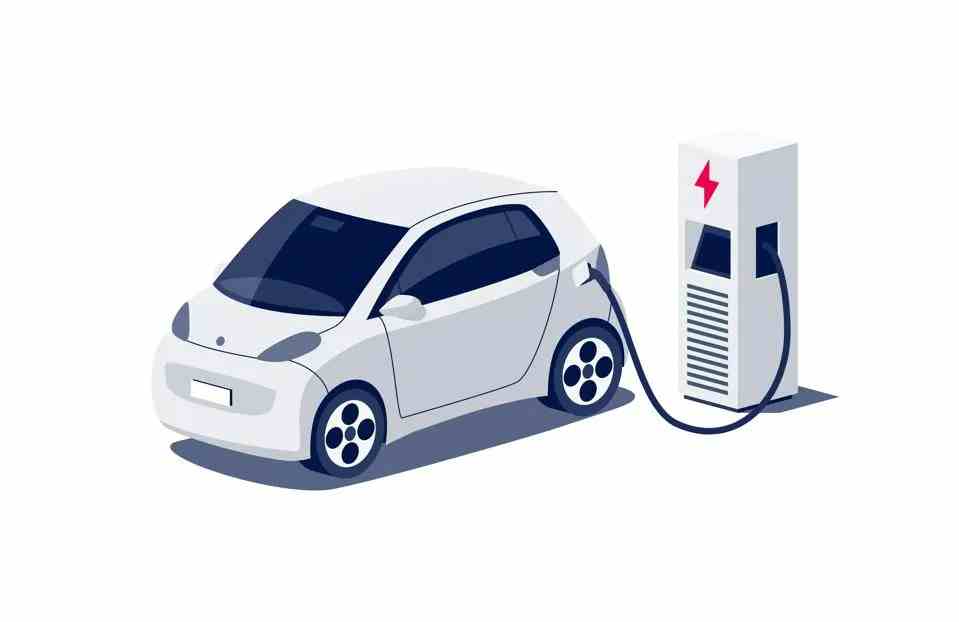In the rapidly evolving world of automotive technology, electric cars have emerged as a beacon of the future. With their promise of zero emissions, improved efficiency, and a departure from our reliance on fossil fuels, they represent a significant shift in how we think about personal transportation. However, as with any new technology, there are questions and concerns that potential adopters face. One such concern is the cost of insuring an electric car. Is it more expensive than insuring a traditional gasoline car? This article aims to delve into this question, exploring the various factors that influence the cost of insuring an electric car and providing a comprehensive understanding of this important aspect of electric car ownership.
Introduction to Electric Cars

Electric Vehicles (EVs) represent a significant shift in the automotive industry, driven by a growing interest in sustainable transportation. An Electric Vehicle (EV) refers to any vehicle propelled by one or more electric motors, using energy stored in rechargeable batteries or another energy storage device. Unlike conventional vehicles that use gasoline or diesel-powered engines, EVs primarily rely on electricity for their functioning, significantly reducing the emission of greenhouse gasses and other pollutants.
Electric vehicles can be classified into three main types based on the energy sources and technologies they use:
- Battery Electric Vehicles (BEVs): BEVs are fully electric vehicles with rechargeable batteries and no gasoline engine. They derive all their power from battery packs and do not emit tailpipe pollutants when driven.
- Plug-in Hybrid Electric Vehicles (PHEVs): PHEVs can recharge the battery through regenerative braking and “plugging in” to an external electrical power source. They can run on electric power, gasoline, or a combination of both.
- Hybrid Electric Vehicles (HEVs): HEVs are powered by gasoline and electricity. The car’s own braking system generates the electric energy to recharge the battery. This is called ‘regenerative braking,’ a process where the electric motor helps slow the vehicle and uses some energy normally converted to heat by the brakes.
What Happens When You’re at Fault in an Accident?
The key components of an electric vehicle include the battery, which stores the electricity that powers the motor, the electric motor that converts electrical energy into mechanical energy, and the charging system.
Factors Influencing Insurance Costs
Here are some factors that might make insuring an electric car more expensive:
- Initial Purchase Price: Electric vehicles (EVs) typically have a higher initial purchase price compared to traditional vehicles, which can lead to higher insurance premiums.
- Cost of Parts: The parts for EVs, especially the batteries, are more expensive. Since the battery can account for a significant portion of the vehicle’s cost, this can increase the insurance premium.
- Battery Replacement: EV batteries have a finite lifespan and may need to be replaced, which can be costly. This is factored into the insurance cost.
- Repair Costs: Repairing an EV can be more expensive due to specialized parts and the need for mechanics with specific expertise.
- Market Growth: As the EV market grows and technology advances, the cost of insuring an EV may decrease due to economies of scale and improved repair networks.
- Insurance Market: The insurance market itself is adapting to the rise of EVs, with some insurers offering specialized policies for electric and hybrid cars.
- Risk Factors: Standard risk factors such as driving history, location, and chosen coverage levels also play a role in determining the cost of insuring an EV.
- Incentives and Discounts: Some insurers offer discounts for EVs due to their safety features and environmental benefits, which can offset higher costs.
Steps to Get Car Insurance Pre-Purchase
These factors combined can make insuring an electric car more expensive compared to a conventional vehicle. However, as electric cars become more mainstream and repair costs decline, insurance rates are likely to decrease.
Insurance Premiums for Electric Cars
Insurance premiums for electric vehicles (EVs) can vary based on several factors, including the make and model of the vehicle, the driver’s record, and the location. Here are some key points to consider:
- Average Cost: On average, car insurance for an electric vehicle is about $337 per month, or $4,043 per year. It costs about 20% more to insure an electric vehicle (EV) than a gas vehicle, mostly because EVs cost more to buy and repair.
- Cost by Vehicle Model: The national average premium for an electric vehicle (EV) was $2,280 per year, according to a Forbes Advisor analysis of 41 top-selling electric car models. However, your electric car insurance costs will vary depending on your car and other cost factors. For example, the analysis found that the Porsche Taycan was the most expensive electric car to insure ($4,683), and the Toyota RAV4 hybrid was the least expensive ($1,776).
- Recent Trends: Insuring electric vehicles now costs roughly the same as conventional gas-powered cars, with annual premiums for each averaging $1,607 and $1,606, respectively. This is a significant change from just two years ago when EVs were 15% more expensive to insure.
Remember, these are averages and actual costs can vary based on factors such as the driver’s record, location, and the specific model of the car. Therefore, it’s always a good idea to get quotes from multiple insurance companies to ensure you’re getting the best rate for your electric vehicle.
Challenges in Insuring Electric Cars
Insuring electric cars presents unique challenges for both car owners and insurance companies. Here are some of the key challenges to consider:
- Battery Costs and Replacement: The high cost of EV batteries significantly impacts insurance premiums. Replacing a damaged battery can be very expensive, ranging from $5,000 to $15,000.
- Repair and Parts: Electric cars often require specialized parts that are more expensive than those for gas-powered vehicles. Additionally, there are fewer qualified mechanics for EVs, which can lead to higher repair costs.
- Underdeveloped Repair Networks: The infrastructure for repairs and servicing of EVs is not as developed as for traditional vehicles. This can lead to longer repair times and higher costs.
- Charging Infrastructure: Insufficient charging infrastructure can be a concern for insurers, as it may increase the risk of accidents due to range anxiety or improper charging practices.
- Claims Management: Managing and controlling claims for EVs can be challenging due to battery costs, supply chain issues, and the need for specialized repair networks.
- Connected Cars: The data-driven nature of connected EVs poses new challenges for insurers, who must adapt to the changing landscape of the motor insurance market.
- Environmental Hazards: EVs may require extra coverage for environmental hazards, given their reliance on electrical components and batteries.
- Market Adaptation: Insurance companies are adapting to the rise of EVs by providing specialized policies, but this is a gradual process, and the market is still evolving.
Do You Need Insurance to Purchase a Used Car?
These challenges highlight the need for a nuanced approach to insuring electric vehicles, taking into account their unique characteristics and the evolving nature of the market.
Insurance Policy Options for Electric Cars

When exploring insurance policy options for electric cars, it’s important to consider the various types of coverage available and the unique aspects of insuring an EV. Here are some key points to cover:
- Third-Party Liability: This is the most basic form of insurance required by law in many countries. It covers damages to other people or property caused by your EV.
- Comprehensive Coverage: Offers extensive protection, including third-party liability and coverage for damages to your own vehicle due to accidents, theft, fire, and natural disasters.
- Collision Coverage: Pays for damages to your EV resulting from a collision with another vehicle or object.
- Personal Injury Protection (PIP): Covers medical expenses for you and your passengers in case of an accident, regardless of who is at fault.
- Uninsured/Underinsured Motorist Protection: Provides coverage if you’re involved in an accident with a driver who doesn’t have insurance or whose insurance is insufficient.
- Battery Coverage: Given the high cost of EV batteries, some insurers offer specific coverage for battery damage or replacement.
- Roadside Assistance: Many insurers provide roadside assistance services, which can be particularly useful for EVs in case of battery depletion or other issues.
- Add-Ons and Endorsements: You can enhance your policy with additional features like zero depreciation cover, engine protector, return to invoice, etc., for an extra premium.
- Dedicated EV Insurance Providers: Some insurance companies specialize in EV insurance and offer tailored policies that address the specific needs of electric car owners.
Why Does Being Unemployed Affect Car Insurance?
It’s advisable to compare different policies and insurers to find the best coverage for your electric car. Look for insurers that understand the intricacies of EVs and offer competitive rates and comprehensive coverage options. Remember to check customer reviews and the insurer’s claim settlement ratio to gauge their reliability and service quality.
Ways to Reduce Insurance Costs
Here are some effective ways to reduce your insurance costs:
- Shop Around: Compare rates from multiple auto insurance companies. Rates can vary significantly, so shopping around ensures you find the best deal.
- Review Your Deductibles: Consider raising your deductibles. A higher deductible means a lower premium. Just make sure you can afford the deductible if you need to file a claim.
- Bundle Policies: If you have multiple insurance policies (e.g., home and auto), consider bundling them with the same insurer. This often leads to discounts.
- Install Security Devices: Adding security devices to your car or home can reduce insurance costs. For cars, anti-theft devices can lower premiums.
- Safe Driving Record: Maintain a safe driving history. A clean record can lead to discounts on your car insurance.
- Loyalty Discounts: Some insurers offer loyalty discounts for long-term customers. Check if your current insurer provides such benefits.
- Group Insurance: Leverage group insurance through your employer or professional associations. Group rates are often more favorable.
- Apply All Available Discounts: Inquire about any available discounts, such as safe driver, good student, or military discounts.
Remember, even small reductions in your insurance premium can add up over time. Explore these options to keep more money in your pocket!
Future Trends
The future of electric vehicle (EV) insurance is expected to evolve along with the growth and changes in the EV market. Here are some anticipated trends:
- Increased EV Sales: According to the International Energy Agency (IEA), worldwide EV sales are projected to grow to nearly 37 million by 2030 — almost four times as many as in 2022.
- Decreasing Insurance Rates: Although EV drivers typically pay higher-than-average insurance rates, costs to insure EVs should fall as vehicle prices moderate and auto insurers adjust coverage options.
- High Repair Costs: High repair costs play a significant role in determining EV insurance premiums. While there are fewer components at risk of breaking down in an EV, the parts that do require repair or replacement are much more expensive.
- Adoption of Usage-Based Insurance (UBI): With the advancement of technology, insurance companies might offer personalized insurance premiums based on the actual usage of the car.
- Impact of Autonomous Vehicles: As autonomous vehicles become more common, they could potentially lower insurance premiums as they are expected to reduce the number of accidents.
- Government Regulations and Incentives: Government regulations and incentives to promote EVs could also influence insurance premiums. For instance, if governments provide incentives for EV ownership, insurance companies may follow suit with lower premiums.
These trends indicate a dynamic future for EV insurance as the market continues to evolve. However, the exact changes will depend on a variety of factors, including advancements in technology, changes in consumer behavior, and shifts in government policy.
FAQs
Q 1. What are the best insurance companies for electric vehicles in the US?
Ans. There are several insurance companies in the US that offer competitive rates for electric vehicles. Some of the top ones include Geico, State Farm, Progressive, and Allstate. However, the “best” company can vary depending on individual needs and circumstances.
Q 2. How does the age of the driver impact the insurance cost of an electric vehicle?
Ans. Generally, younger drivers (especially those under 25) tend to pay higher insurance premiums due to their lack of driving experience and higher risk profile. As the driver ages and gains more driving experience, the insurance premiums typically decrease.
Q 3. Are there any specific insurance policies for electric vehicle owners who install home charging stations?
Ans. Some insurance companies may offer additional coverage for home charging stations as part of their homeowners insurance policy. It’s best to check with your insurance provider for specific details.
Q 4. How does the range of an electric vehicle impact its insurance cost?
Ans. The range of an electric vehicle can potentially impact its insurance cost. Vehicles with a longer range may cost more to insure because they tend to be more expensive to purchase and repair.
Q 5. How do safety ratings for electric vehicles impact insurance premiums?
Ans. Safety ratings can significantly impact insurance premiums. Vehicles with higher safety ratings are often cheaper to insure because they are considered less risky.
Q 6. How does the cost of insuring a used electric vehicle compare to a new one?
Ans. Insuring a used electric vehicle can often be cheaper than insuring a new one. This is because used vehicles typically have a lower value, which can result in lower insurance premiums.
Conclusion
In conclusion, while it’s true that electric vehicles (EVs) can be more expensive to insure than their gasoline counterparts, the gap is closing as EVs become more mainstream and insurance companies gather more data on them. The cost of insuring an EV is influenced by several factors, including the cost of the vehicle itself, the cost of parts and repairs, and the perceived risk by insurance companies.
However, there are ways to lower these costs, such as shopping around for the best rates, bundling insurance policies, or taking advantage of discounts offered by some insurance companies for electric or hybrid vehicles. As the EV market continues to evolve, we can expect to see changes in insurance premiums. Ultimately, the decision to switch to an electric vehicle should be based on a variety of factors, including the potential for lower fuel costs, reduced emissions, and the overall cost of ownership, which includes insurance premiums.

Milo Thistlethwaite is an auto insurance guru with over 8 years of experience in the industry. Holding a CPCU (Chartered Property Casualty Underwriter) certification, Milo is passionate about helping drivers find the best coverage for their needs. As an author on the ‘FundFinesse’ blog, Milo writes clear, easy-to-understand articles about auto insurance.


